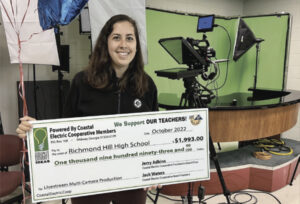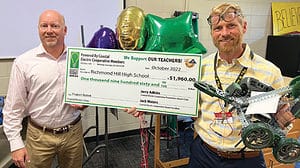Thanks to the generosity of Coastal Electric Cooperative members, local teachers recently received $40,000 in Bright Ideas grants to fund their innovative project ideas.

Funding for Bright Ideas grants comes from Coastal Electric members who allow their electric bills to be rounded up to the next dollar through Operation Round Up. Those nickels and dimes are pooled together and invested back into the community through the Coastal Electric Cooperative Foundation.
Since the Bright Ideas program’s inception in 2002, close to $450,000 has been awarded to give local teachers the power to put their creative teaching ideas into action.
In addition, the foundation presented $1,000 checks to 24 principals in Bryan, Liberty and McIntosh counties to be donated to their Principals Funds, with the intention the monies would be used to meet students’ and teachers’ needs throughout the school year.
“These children are our future and most valuable resource,” says Coastal Electric Cooperative CEO Chris Fettes, who presented donations on behalf of the Foundation. “We are here to support the dedicated people who work hard every day to provide a top-notch education and enhance our students’ quality of life.”
With eight winners, Richmond Hill Middle School received the most Bright Ideas grants of any one school this year. Among the winners was Lisa Tuttle’s $1,940 grant project, Exploring Energy Alternatives, which will allow students to investigate using alternative sources to power neighborhoods and then build a model of their community; and Andrew Robertson’s $1,007.86 project, The Effect of Color, which will allow students to research the effects different colors of lighting have on mood, attention and creativity.
Robert Todd at McIntosh County Academy (MCA) won a $1,805.26 grant to fund his project, Outdoor Classroom Dock with Fish Feeder. The project will enhance the outdoor classroom area, providing easier access to students studying water qualities and Georgia aquatic species. The project will also provide space for demonstrations of vessel/ dock and marine water safety, which like the study of ecosystems, are major elements of the Commercial Fisheries Pathway curriculum at MCA. The project will help prepare students for occupations in commercial fisheries (one of the community’s two biggest economic industries), along with possible opportunities with the Coast Guard, U.S. Department of Natural Resources and local/state extension agencies.

McAllister Elementary School’s Sarah Chancey won a $763.32 grant to fund her project, 3D Solutions, which will allow students to 3D-print designs they make in a science unit that focuses on erosion. As a culminating activity, students will design solutions to ease coastal erosion. By designing these prototypes, students become real-world problem solvers and can become part of something that can actually make a difference in the lives around them.
Tiffany Leon-Peterson won a $1,894.83 Bright Ideas grant to fund her project, BOOST My Mindstorm. The project will allow Taylors Creek Elementary School students learning English as their second language to develop in the content area of computer science through robotics, coding and problem-solving. Students will also enhance their English listening, speaking, reading and writing skills.

At the Bradwell Institute, Ashley Johnston won a $913.70 Bright Ideas grant for students to build a working, large-scale Roman aqueduct. Students will measure and construct the aqueduct, which will use gravity to allow water to flow into three cisterns that would, in turn, feed three areas of ancient Rome: fountains, public baths and plumbing for wealthy homeowners. The final product will measure approximately 30 feet long, 5 feet wide and 3.5 feet tall.
Joseph Martin Elementary School’s Sarah Trawick won a $1,985.83 grant for her project idea, 5th Grade’s ExCELLent Museum. Students will explore the school campus to collect plant, insect and animal samples that they will use to create microscope slides. Students will then work in small groups and use the microscopes to study cells of their samples. The project will culminate with students researching an organism for which they have a cell sample and creating a corresponding art project of the cell they observed for a museum walk-through event.
To learn more about this year’s Bright Ideas grant winners, connect with Coastal Electric on Facebook, Instagram and Twitter.
